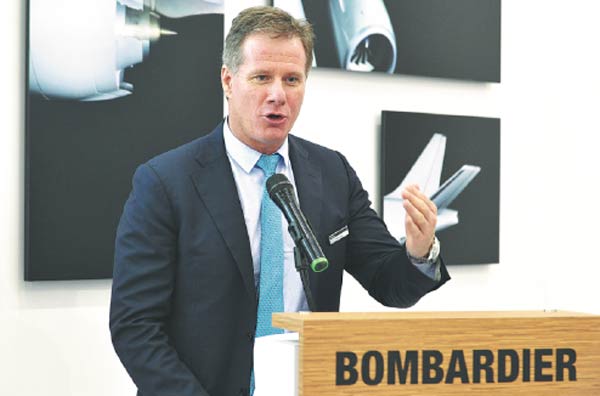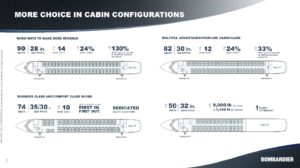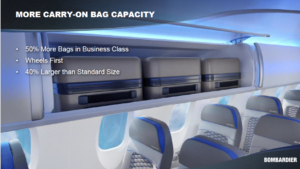Leeham News and Analysis
There's more to real news than a news release.
Leeham News and Analysis
- Boeing ponders 16/mo production rate for 787
- At long last, Boeing appears near certification and EIS for 777X
- Air India Flight 171 Preliminary Crash Report Is Unclear Regarding Pilot Actions
- Bjorn’s Corner: Air Transport’s route to 2050. Part 30.
- It’s official: MTU’s engine leader named CEO of Airbus Commercial from Jan. 1; future of Open Fan and A220-500 shifts to him
Bombardier admits shortfall on Q400, CRJ, vows comeback
Sept. 13, 2017, © Leeham Co.: Bombardier wasn’t “fully at the top of its game for focus and messaging on the Q400 and CRJ,” a top official admitted Tuesday. But the company is “turning that around” and initial results were seen at last summer’s Paris Air Show with a spurt of orders for the turboprop airliner.
Colin Bole, SVP Commercial made the remarks at BBD’s media day at its Mirabel CSeries/CRJ production site.
Q400 vs ATR-72
Officials touted previously cabin changes to the Q400, and its performance advantages—from Bombardier’s perspective—over the competing ATR 72.

Colin Bole. Photo via Google images.
But ATR currently has 85% to 90% of the current turboprop backlog (excluding the captive Chinese and Russian markets).
BBD officials said they see a shift emerging that will support sales of the Q400 over the ATR-72.
“There was a need for more basic requirements than there will be going forward,” said Todd Young, Q400 program manager. Airlines are trending toward wanting to board from a gate vs ground level, something the forward-door permits on the Q400 and the aft door on the ATR does not.

Bombardier now offers several cabin configurations for the Q400 to make it more flexible and attractive,
More capacity is needed; hot-and-high performance will be important in emerging markets like India, China and Southeast Asia; and the Q400’s higher cruising speed makes it easier to catch up to schedule to retain the “integrity” of hubs, Young said.
“In the past, the ATR has been successful for basic solutions, but the market is shifting,” he said.
Bole pointed to the unusually and unexpected strong performance at the Paris Air Show, at which BBD announced orders and commitments for 34 Q400s. ATR announced only 17 orders and commitments, but just four of these were for the Q400’s competing ATR-72.
Bole said Bombardier is also focused on reducing production costs of the Q400 to price it more competitively with the less expensive ATR.
CRJ vs E-Jet
Bombardier revealed a new round of cabin upgrades for the CRJ that go beyond previously implemented larger overhead bins and other improvements.
Called Atmosphere, this includes enlarged bins again, a larger, wheel-chair accommodating lav, mood lighting and other upgrades.
“The biggest criticism of the CRJ was the cabin,” Bole said. “We’re addressing that. We have the lowest set-mile costs.”
Bole said there is a wide customer base for the CRJ and in the last five years, more than 25 operators for used and new CRJs have been added to the base.
“The market share is low and the backlog is lower than we’d like, but we have the flexibility to adjust production rates,” Bole said.
Still, officials see hope in the future for a resurgence, and it lies mainly with the US Scope Clause.
Scope limits the size, number and weight of aircraft regional airlines can operate for the legacy partners. Embraer and Mitsubishi need scope relaxation on the weight of the airplanes to permit their E175-E2 and MRJ90 to be operated by the regional carriers. Both weigh too much.
Bombardier believes there won’t be any relaxation in the next round of contract negotiations in 2019. The airlines are making money, give-backs aren’t required, there’s a pilot shortage and other factors that played a role in previous relaxation don’t exist.
The CRJ700 and CRJ900 fit within the scope clauses (as do the E175-E1 and MRJ70), and BBD officials claim their airplanes are more economical than any of the others in the same class. (Embraer in particular disputes the claims.)
Share this:
- Click to print (Opens in new window) Print
- Click to email a link to a friend (Opens in new window) Email
- Click to share on X (Opens in new window) X
- Click to share on Pinterest (Opens in new window) Pinterest
- Click to share on Facebook (Opens in new window) Facebook
- Click to share on WhatsApp (Opens in new window) WhatsApp
- Click to share on LinkedIn (Opens in new window) LinkedIn
- Click to share on Tumblr (Opens in new window) Tumblr
- Click to share on Reddit (Opens in new window) Reddit
Related
Category: Airlines, ATR, Bombardier, Embraer, Mitsubishi, Paris Air Show
Tags: ATR, ATR 42, ATR-72, Bombardier, Colin Bole, CRJ, CRJ-700, CRJ-900, Q400, Todd Young



Aircraft such as the Q400 and ATR42’s are often forgotten depending what parts of the world you come from. As airstrip infrastructure improves smaller jet aircraft takes over their roles.
But on the other hand new destinations are developing in emerging parts of the world. The Q400 is not a small aircraft and is relatively sophisticated.
I can see application for a smaller (~3.5m shrink) of the Q400, seating ~65 pax (vs 82), using the same wing and engines. This will give good field performance, especially at higher elevations.
Improved range is not always for connecting two points but in remote destinations availability and/or quality of fuel is often a problem. Such an aircraft could potentially fly in and out of such less developed/remote destinations without re-fueling.
Improvements of the Q400’s landing gear is an area BBD could look into in general, this could potentially also increase MLW?
I have to disagree they are rough strip operations.
AK Airlines operates them all over the mountain west into paved strips that can handle large single aisle (737/A320)
FedEx operates a large number of ATRs and virtual all are into paved runways, many single aisle capable as well.
I believe that is true of 99% of both fleets.
Could BBD do a simple CRJ-NEO to further improve the seat mile cost?
See the CRJ-700 size were there is a theoretical market gap developing which BBD could exploit and improve on the aircraft.
Not a lot of airlines will go for the CRJ-900 if they can get the E175E2 at fairly similar price. The US “restrictions” are actually keeping the -900 alive, just.
So, at least some things in the US are working in the favor of BBD.
One of the aspect BBD cannot change is the engine disparity.
The Q400 runs about twice the hp of the ATR.
That gives it the better performance but has an economic impact.
What BBD failed to convey was that you can throttle back the Q400 and come close to ATR burn rates.
The engines will always be a major factor in cost as well the maint on those engines.
I think it can be justified but it can’t be removed.
Why dont they just admit the ‘high power- faster’ strategy just isnt working and revert to lower cruise speed engines.
With the big drop in fuel prices the previous ‘faster but more rotations’ approach should be delivering but isnt. Its banging your head to not compete directly in this area.
BBD has always been focusing on performance advantages. They had little choice because the significant higher purchase, fuel burn (OEW based) and operating costs have to be justified.
ATR can upgrade their lean and mean machine to increase load, speed, range. (The -600 upgrade really buried BBD in hindsight). For BBD to do the opposite direction is more difficult.
Plus, the ATR is a family concept. The Q200, 300 went out of production in 2009. If BBD developed a simple stretch of the -300 without hot/high performance/costs, maybe things would have been different.
Thanks Keesje, you spelled out what I tried to say, an Q300+ could have done the trick. Always “felt” better for me flying in the Q300 than the Q400. Only flew twice in the ATR72, “what you see is what you get”.
Wonder if BBD ever considered an aircraft along the lines of the AN148/158? PW1715G’s (15Klb) could be a potential engine option.
BBD can do the Q400 stretch as it has plenty of Power. The design is almost finished and they can after certification license a conversion of present Q400’s to 99pax Q400XL’s to independent MRO’s and to their Chinese partners. Maybe a new gbx gear ratio and new prop will be a good choise otherwise will Reinbeck be there offering a suitable prop for a Q400XL.
Raisbeck Engineering, typo above
See Embraer looking at building a new turboprop in the Q400/ATR72 class.
A stretch is really the answer for the q400.
As it is, it has more than enough power and wing to support a 4 or 5 row stretch. The increase in empty weight would be offset by shorter range but even if it still has a 7-800nm range, that puts it right in the sweet spot of most Tprop routes, and would give it world beating CASM.
It would differentiate itself from the ATR, allow BBD to offer 2 planes to airlines, and breath new life into the Q.
Most of the great comments are focused on aircraft performance, but BBD also need to focus on customer support improvements, such as spare parts availability and FSR support, which have deteriorated during their financial slumps.